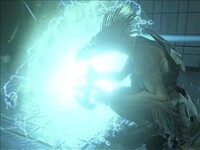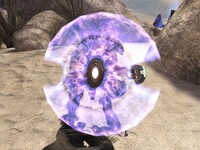Kig-Yar point defense gauntlet: Difference between revisions
From Halopedia, the Halo wiki
No edit summary |
3vil D3m0n (talk | contribs) mNo edit summary |
||
| Line 1: | Line 1: | ||
{{Era|H1|H2|H3|FOR|TF|FS|GOO|UP|RVB|HGN|HW|TCP|H3R|LE|}} | {{Era|H1|H2|H3|FOR|TF|FS|GOO|UP|RVB|HGN|HW|TCP|H3R|LE|RE|}} | ||
{{ratings}} | {{ratings}} | ||
[[Image:Jackal Point Defense Gauntlet.jpg|thumb|300px|A deactivated Point Defense Gauntlet being carried by a [[Jackal]] in ''[[Halo 3]]''.]] | [[Image:Jackal Point Defense Gauntlet.jpg|thumb|300px|A deactivated Point Defense Gauntlet being carried by a [[Jackal]] in ''[[Halo 3]]''.]] | ||
Revision as of 08:11, February 14, 2010
Point Defense Gauntlets[1] are arm-held energy shields mainly used by the Covenant Kig-Yar for protection from enemy fire or close to mid-range explosions. Elites are known to use their own version of an arm energy shield, the Sangheili Point Defense Gauntlet.
Summary
Worn on the forearm, they create a barrier that can deflect all solid projectile weaponry to a certain point, mostly UNSC weapons; however, Jackals are also seen to attempt using the shield as protection against grenades, with rarely any success. Grenades are now the best tactic to use when confronted by an enemy with such a device. Another tactic is to fire in the right and left handed notches from which the Jackals fire, or shoot the heads that are slightly overlapping the shields. It's also possible to snipe a Jackal's feet if it is not moving, even though only a small portion of the foot can be seen. Although the shield will deflect light projectiles, heavier guns, such as the M41 Light Anti Aircraft Gun or Gauss Cannon, are effective against the shield.
Damage Resistance
The shield of the point defense gauntlet reflects its current charge by changing color gradually from its original color to red before it deactivates completely.
In Halo 2, the shield appears to have been weakened and become stronger at the same time. It is now possible (although difficult) to bring down a shield with projectile weaponry; a sniper round to the central dot will collapse it and stun the Jackal. The strong points are that the shield gives some melee protection and can still deflect Needler rounds like in Halo: CE, although rapid fire may cause the rounds to stick to the actual gauntlet, therefore exploding and killing the Jackal.
Halo 3-era Jackal shields are the strongest yet, unable to be collapsed by standard projectile UNSC weapons (even to shots to the central dot), and melees no longer instantly kill the Jackal, they just deactivate the shield. Jackals also will not flinch when ammunition hits the edges of their shields, they will only flinch when a bullet comes in contact with their body (particularly the hand exposed by the firing notch). It is more susceptible to the Plasma Rifle and Sentinel Beam now, however. A Plasma Pistol overcharged will instantly deactivate the shield, so you can then use a different weapon to kill the Jackal.
Halo: Reach In the recently released vidoc, the second flash of sticky notes shows a sticky that says "Jackal Shield WOW". Most of the sticky notes with WOW on them are on new features, so it may be available for player use. Also, a sticky note mentions "Jackal Phalanx", which could become a new formation for Jackals.
Although rarely seen, the Jackal's shield will be somehow almost completely dissipated when accidentally hit by a Brute Power Drain, and is unknown to be vulnerable to attack when affected.
UNSC Weapons
The Jackal Point Defense Gauntlet is completely resistant to the UNSC's metallic projectile ammunition. Most UNSC weaponry will simply bounce off the shields. Even the SRS99D-S2 AM Sniper Rifle's large 14.5mm APFSDS rounds are deflected.
However continuous fire from certain weapons will cause the Jackal to momentarily drop its shield. The Warthog's M41 LAAG, AIE-486H Heavy Machine Gun (and curiously MA5B and SMG in Halo: Combat Evolved and Halo 2) rounds will cause the Jackal to flinch, allowing the rest of the weapon's bullets to eliminate the Jackal. This may be due to the physical weakness of the Jackal as the bullets themselves are deflected. Only the Gauss Cannon round is not deflected by the Jackal's shield, although the M41 LAAG, after long enough, will deplete the shield.
The few Human weapons that can penetrate the shield are explosive weapons such as the Rocket Launcher, Missile Pod, Spartan Laser, or vehicle mounted ones such as Gauss Cannon and normal Warthog turret.
Covenant Weapons
Alternatively, the Point Defense Gauntlet has very low resistance towards Covenant Plasma-based weaponry. Plasma fire will deplete the shield's strength until they completely collapse. A few shots from a Plasma Rifle or a Plasma Pistol overcharged shot will successfully collapse the shield and may also cause the Jackal to flee.
Strangely the Covenant Carbine, a projectile weapon, can also deplete the shield. This, however, may be due to the fact the Carbine operates in a smaller but similar fashion like a Fuel Rod Gun, as stated by the Halo 2 game manual, unlike human projectile weaponry.
Grenades
Explosions from grenades can collapse the shield and kill the Jackal, instantly if its close enough. It should be noted that the Plasma Grenade and the Spike Grenade will not stick to shield (though in pre-production it was planned for the Spike Grenade to have this ability) but can still destroy the shield and the Jackal if it's near the explosion.
Melee
In Halo: Combat Evolved, a direct hit to the shield will knock it backwards into the Jackal, sending a power surge through the Jackal's body, thus killing it. However, on Heroic and Legendary, it will often take more than one attack. Similar to most enemies, Jackals flinch when hit with a melee attack. In Halo 2, the shield now provides the Jackals with limited melee protection, but in Halo 3, a melee attack will just collapse the shield.
Changes from Halo: Combat Evolved to Halo 2
- Shields now slowly turn a red color as they take more and more damage.
- Jackal Majors are indicated by orange shield and orange armor, rather than brownish skin.
- Gaps for firing weapons is slightly smaller.
Changes from Halo 2 to Halo 3
- In Halo 3, Jackal Majors are indicated by a purple-blue color in their shield, rather than orange.
- Unlike the first two games, a Jackal's shield protects against melee attacks. A melee collapses the shield on lower difficulties with one hit, while it takes a couple on Legendary (weapons like the Energy Sword will cut through it instantly, no matter the difficulty).
- Shields will recharge significantly faster than in the first two games.
- Small gap for the firing weapon is slightly larger and can more easily be exploited by the player.
Trivia
- The Jackal shield is only available for use by players through mods.
- In the first teaser of Halo: Combat Evolved, a group of UNSC Marines that were inside a Forerunner complex, engage with a Major Domo Elite with a triple-layered personal arm shield similar to the Jackal's. This was later replaced with the Energy Shield.
- In Halo 2, the Arbiter's zoom outline resembles that of a horizontal Jackal Energy Shield from Halo: Combat Evolved.
- Sniper Jackals wear Point Defense Gauntlets but never use them, even after dropping their rifles or carbines and fleeing.
- It seems that Rtas 'Vadum has his own personal arm shield. This can be seen in the Halo Graphic Novel.
- Point Defense Gauntlets were often used by Spartans and Elites who wanted enhanced shielding. They are commonly used by Spartan-IIIs, as their SPI armor doesn't include a built-in energy shield.
- The early MJOLNIR armor's shield system was reverse engineered from a Point Defense Gauntlet but due to the shield being stretched, projectile weapons will collapse it.
- The shield seems to be a dual-wieldable item, as Jackals are never seen holding a weapon in their shield hand, as this would interfere with their shield, aim, and posture, and the shield may get in the way of their weapon (one exception is in a Halo 2 glitch where the Arbiter could give shield bearing Jackals two-handed weapons). In Halo Wars, they can hold a Covenant Carbine or Beam Rifle, along with the gauntlet, with ease.
- Jackals are the only Halo characters, other than Rtas' Vadum, that are left-handed, as their shield is in their right hand.
- Apparently, Jackal shields in the novels run out of energy where as in the game it is rechargeable.
- In Halo 3, the Point Defense Gauntlets will recharge (reactivate) after collapsing in approximately 12 seconds.
- Kig-Yar Point Defense Gauntlets appear to be slide-on with size adjustments.
- If you look in Theater, a Marksman's shield will float while he reaches for his weapon.
- Jackal Snipers and Jackal Marksmen do carry these Gauntlets as others do, but do not activate them as their weapons (Carbines and Beam Rifles) are too heavy for one handed operation.
- In Halo PC the coloring for the Jackal's personal energy shield will not be the correct color. Normally the Major is yellow and the Minor is blue, however in the PC version it is a light green-blue for all of them. This may be because that jackal shields were plasma and plasma was light green.
- Originally in Halo 2, some Carrier Forms would have an Energy Shield that looked similar to the Jackal shield (see Shielded Flood Carriers).
- If you shoot a Jackal with a shield, and kill them, even without shooting their shield, it collapses, probably due to a fail-safe. It is likely reactivated when it is picked up again.
Sources

